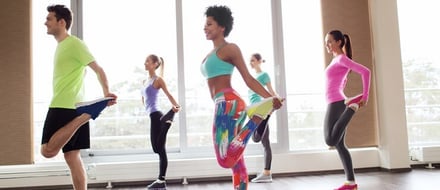MAKE A SPLASH
THIS SUMMER

Join Now For $0 Enrollment!
Learn MorePosted By: Chicago Athletic Clubs /

If you don’t have a lot of time to spend in the gym, it’s tempting to just hop off the treadmill and into the shower or to skip a group fitness class’s final stretching portion. But sticking around to stretch, if even for a few minutes, is key to reaching your fitness goals.
“Stretching helps improve your range of motion, which can boost your athletic performance and decrease your risk of injury,” says Megan Reiling, an elite-level personal trainer at Lincoln Park Athletic Club. “The greater range of motion you have, the less likely you are to get hurt because you’ll have the flexibility to do the exercises properly.” And doing exercises properly means better, faster results, she says.
Here are some do’s and don’ts to help you make the most of your stretch time.
Don’t … stretch before your workout. You could hurt yourself if you stretch cold muscles, says Reiling. Plus, research shows stretching before a workout may actually hinder performance. It made runners run more slowly, kept jumpers from jumping extra high, and made weightlifters lift less weight, according to a study in the Scandinavian Journal of Medicine & Science in Sports.
Do … complete a dynamic warmup. Instead of static stretching such as touching your toes before a workout, Reiling suggests a dynamic warmup to prime muscles and joints for what’s to come. Try doing high leg kicks, lateral lunges, forward lunges, and inchworms (walking your hands out until you’re in a plank, then returning to standing).
Don’t … rush it, especially after a tough workout. Plan your schedule and routine, so you have 10 to 15 minutes to stretch after your workout, especially if you did something new or particularly strenuous. “Your muscles could be more sore than usual, so it’s important to stretch them out,” says Reiling.
Do … hold each stretch. Ideally, hold each stretch for 30 seconds, says Reiling. For tighter areas, you may want to hold it a little longer — up to 60 seconds. During the stretch, focus on your breath, says Bill Boland, an exercise physiologist based in New York City. “Using your breath helps your muscles relax,” he says. “It tells them, ‘Don’t worry, I’m OK.’ “
Don’t … be competitive about stretching. A little healthy competition with a gym buddy can be a good thing — but not when it comes to stretching. “Don’t worry about how flexible the people are around you,” says Boland. “It’s not important that you touch your toes — it’s important that you improve your mobility, and that looks different for every person.”
Do … focus on major muscle groups. The main areas that need stretching are calves, hamstrings, thighs, hips, lower back, neck, and shoulders. “If you sit at a desk all day, your hips, hamstrings, neck, and back muscles might be especially tight,” says Reiling. Try these simple stretches:
Hamstrings: Stand and flex right foot. Keeping right leg straight and right heel on floor, bend left knee and hinge forward at hips to feel the stretch; repeat on the other side.
Hips: Stand on right leg and place left ankle just above knee. Bend right leg and sit back into your hips, holding onto a chair or wall if needed; switch sides.
Neck and shoulders: Clasp hands behind back and roll shoulders back while pushing hips forward. Roll head from side to side to feel the stretch in your neck.
Don’t … bounce or pulse while stretching. “This is a common mistake, and it can lead to injury,” warns Reiling. Instead, keep your stretch steady and controlled.
Do … take stretch breaks at work. The gym isn’t the only place where you should stretch your muscles. “Try to get up from your desk every 20 minutes to do a quick stretch,” Boland says. “It doesn’t have to be anything big — just a quick leg or overarm stretch can keep your muscles from getting too tight.”
| Chicago Athletic Clubs
| Chicago Athletic Clubs
| Chicago Athletic Clubs
| Chicago Athletic Clubs
| Chicago Athletic Clubs
© 2025 Chicago Athletic Clubs. All Rights Reserved. Privacy PolicyEmployee Login
https://www.chicagoathleticclubs.com/
https://www.chicagoathleticclubs.com/services/personal-training/
0
5000
true